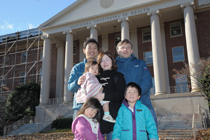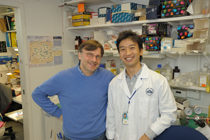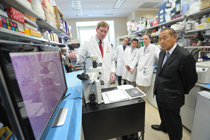From Earthquake to NIH Lab
Wataru Sakamoto was inserting a long needle into the gut of one of his cancer patients to drain some fluid at the moment the 9.0 magnitude earthquake hit in Japan on March 11, 2011.
The quake lasted for a six-minute eternity, moved the entire island eight feet to the east, and culminated in a devastating tsunami that wiped out whole towns and took more than 15,000 lives. Then came the radiation horror as the Fukushima Daiichi nuclear facility began to fail a few days later, spewing radioactivity across the region.
The tsunami displaced hundreds of thousands of Japanese living in Fukushima, the stricken prefecture. Sakamoto—a surgeon at Fukushima Medical University and at a hospital in the small city of Koriyama—was one of them. Fearing the radioactive fallout from the unstable reactors, he moved his wife and three children (including a newborn) to Hokkaido in the north while he continued his work at the Koriyama hospital about 12 miles beyond the forced evacuation zone.
Sakamoto spoke of the confusion in the days after the quake, as most in the region were without power and phone connections. The hospital he was working in needed to take in patients from another hospital, just a few blocks away, that was heavily damaged.

Bill Branson
Scientist Wataru Sakamoto (top left) and his family left Japan after the 9.0 magnitude earthquake that devasted their country on March 11, 2011. He is now working at NIDDK with Jürgen Wess (top right) and hopes to be at NIH for two years.
Now Sakamoto and his family are in the relative calm of Rockville, Md., while he starts what he hopes will be a two-year stint at the NIH, presently in Jürgen Wess’s NIDDK lab in Building 8 on the Bethesda campus. The NIH Japanese Scientists Association (NJSA) coordinated the visit; Fukushima Medical University is paying for Sakamoto’s first year abroad.
NJSA, a volunteer organization of NIH and FDA Japanese researchers, was created in response to the Japanese earthquake disaster. Although lacking major funds, NJSA has sought to arrange for Japanese scientists to visit the NIH and also searched for surplus equipment to send to Japan.
Sakamoto is the first Japanese scientist to come to the NIH for an extended visit under an NJSA arrangement. (Researcher Misako Sato was working in Lalage Wakefield’s NCI lab when the quake hit, and NCI allowed her to postpone her scheduled to move to Sendai, Japan, for several months. In September, NJSA also helped Keiichi Itoi of Tohoku University, in Sendai, spend one month in Greti Aguilera’s NICHD laboratory, while he stayed in the home of NIAID’s Eric Long.)
Sakamoto, a gastrointestinal surgeon with both M.D. and Ph.D. degrees, wants to learn more about molecular biology to better understand tumor pathology as well as diabetes, which is on the rise in Japan.

Bill Branson
Jürgen Wess (left) invited Wataru Sakamoto to work in his lab at NIDDK after Sakamoto and his family were displaced by the earthquake in Japan in March.
Having arrived in October, Sakamoto already is elbow-deep in ongoing research in Wess’s lab on G protein–coupled receptors, one of the largest protein families, which mediate the functions of myriad extracellular ligands such as neurotransmitters and hormones. Wess leads the Molecular Signaling Section in NIDDK’s Laboratory of Bioorganic Chemistry.
Sakamoto has two goals for his stay—to publish in English and to present at a major international meeting in English. Although from highly industrialized Japan, Sakamoto so far has found his visit eye-opening in two ways: the NIH is huge, and the Bethesda area is expensive.
Grateful for the opportunity to come to NIH, Sakamoto looks forward to meeting new colleagues and collaborators.
NIH Hosts Japanese Ambassador and Vice Versa

Ernie Branson
Marston Linehan (NCI) and his team took turns explaining their research toJapanese ambassador Ichiro Fujisaki (right), who visited NIH in June. The ambassador was grateful for the help NIH provided to Japanese scientists after the March 2011 earthquake and tsunami disasters.

Ernie Branson
The Japanese Embassy honored NIH researchers with several awards. Pictured (left to right) : Michael Gottesman, Keiko Ozato, Yoshi Yamada, and Ambassador Fujisaki.
NIH researchers wowed Japanese Ambassador to the United States, Ichiro Fujisaki, during his visit to NIH in June.
In November, he hosted a reception to celebrate the U.S.–Japan Biomedical Research Cooperation and mutual friendship among Japanese NIH researchers. He bestowed awards to NIH’s Division of International Services—in recognition of its exceptional dedication in accepting Japanese researchers to NIH—and to Michael Gottesman (Deputy Director for Intramural Research) and senior investigators Keiko Ozato (NICHD) and Yoshi Yamada (NIDCR) for NIH’s support of the Japanese research community after the March 2011 earthquake and tsunami disasters.
This page was last updated on Monday, May 2, 2022
